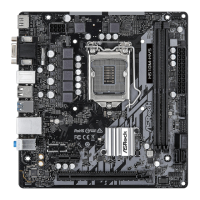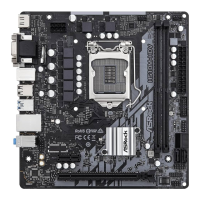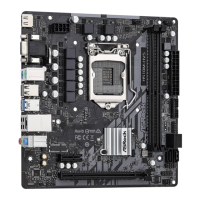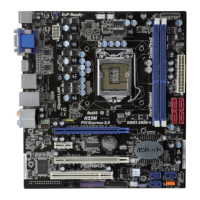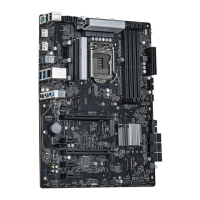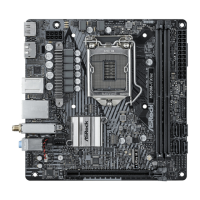
Do you have a question about the ASROCK H510M-ITX/ac and is the answer not in the manual?
| Cables included | SATA |
|---|---|
| Drivers included | Yes |
| Audio chip | Realtek ALC897 |
| Certification | FCC, CE, ErP/EuP |
| Component for | PC |
| Motherboard chipset | Intel H510 |
| PC health monitoring | CPU, FAN, Temperature, Voltage |
| Audio output channels | 7.1 channels |
| Motherboard form factor | mini ITX |
| Motherboard chipset family | Intel |
| Windows operating systems supported | Windows 10 x64 |
| DisplayPort version | 1.4 |
| DVI-D ports quantity | 0 |
| WiFi-AP antenna jack | 2 |
| USB 2.0 ports quantity | USB 2.0 ports have a data transmission speed of 480 Mbps, and are backwards compatible with USB 1.1 ports. You can connect all kinds of peripheral devices to them. |
| LAN controller | Intel® I219-V |
| Wi-Fi standards | 802.11a, 802.11b, 802.11g, Wi-Fi 4 (802.11n), Wi-Fi 5 (802.11ac) |
| Top Wi-Fi standard | Wi-Fi 5 (802.11ac) |
| Ethernet interface type | Fast Ethernet, Gigabit Ethernet |
| Number of SATA III connectors | 4 |
| Supported storage drive types | HDD & SSD |
| Supported storage drive interfaces | SATA III |
| Processor socket | LGA 1200 (Socket H5) |
| Compatible processor series | Intel Celeron, Intel Core i3, Intel Core i5, Intel Core i7, Intel Core i9, Intel Pentium |
| Memory channels | Dual-channel |
| Memory slots type | DIMM |
| Supported memory types | DDR4-SDRAM |
| Maximum internal memory | 64 GB |
| Supported memory clock speeds | 2133, 2400, 2666, 2800, 2933, 3200 MHz |
| OpenGL version | 4.5 |
| DirectX version | 12.0 |
| Maximum resolution | 4096 x 2304 pixels |
| Parallel processing technology support | - |
| BIOS type | UEFI AMI |
| ACPI version | 6.0 |
| BIOS memory size | 128 Mbit |
| System Management BIOS (SMBIOS) version | 2.7 |
| Harmonized System (HS) code | 84733020 |
| Width | 170 mm |
|---|
Lists items included with the motherboard package.
Details platform, CPU, chipset, memory, and expansion slot specifications.
Diagram showing motherboard component placement with numbered labels.
Diagram and description of the motherboard's rear input/output ports.
Details the integrated WiFi and Bluetooth module.
Step-by-step guide for connecting WiFi antennas to the motherboard.
Safety and handling guidelines before installing motherboard components.
Step-by-step instructions for installing the CPU into the socket.
Guide for mounting the CPU cooler and heatsink.
Instructions for installing RAM modules into the DIMM slots.
Explains the usage of the PCI Express slot for expansion cards.
Details the function and setup of motherboard jumpers, specifically the Clear CMOS jumper.
Describes system panel header and other onboard connectors.
Guide for installing M.2 SSD modules.
Instructions for installing motherboard drivers from the support CD.
Overview of the A-Tuning utility for system monitoring and control.
Steps to download and install the ASRock Motherboard Utility.
Overview of the A-Tuning utility's main sections.
Details the ASRock APP Shop for software downloads and updates.
Explains the User Interface of the ASRock APP Shop.
Guide on how to find and install applications from the ASRock APP Shop.
How to update BIOS and drivers using the ASRock APP Shop.
Configuration options within the ASRock APP Shop settings.
Introduction to the RGB lighting control utility.
Explains how to enter and use the UEFI SETUP UTILITY.
Overview of the BIOS EZ Mode dashboard and its functions.
Details the advanced BIOS configuration options.
Lists the main menu options available in the UEFI Setup Utility.
Explains keyboard shortcuts and navigation within the UEFI utility.
Describes the system overview displayed on the UEFI Main screen.
Details the options for overclocking configurations in the BIOS.
Overview of advanced BIOS settings sections.
Explains CPU-related settings in the BIOS.
Details BIOS settings related to the motherboard chipset.
Describes BIOS settings for storage devices and controllers.
Configuration options for Super IO features like PS2 Y-Cable.
Settings related to ACPI power management and wake-up events.
BIOS settings for USB controllers and ports.
BIOS settings for security device support.
BIOS utility tools like ASRock Polychrome RGB and Instant Flash.
Interface for monitoring system hardware status.
BIOS settings for system passwords and secure boot.
Configuration of boot settings and device priority.
Options for saving/discarding changes and exiting the UEFI utility.
